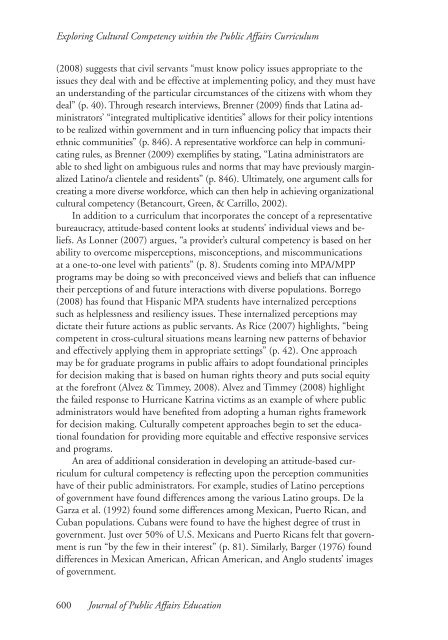Exploring Cultural Competency Within the Public Affairs Curriculum
Exploring Cultural Competency Within the Public Affairs Curriculum
Exploring Cultural Competency Within the Public Affairs Curriculum
You also want an ePaper? Increase the reach of your titles
YUMPU automatically turns print PDFs into web optimized ePapers that Google loves.
<strong>Exploring</strong> <strong>Cultural</strong> <strong>Competency</strong> within <strong>the</strong> <strong>Public</strong> <strong>Affairs</strong> <strong>Curriculum</strong><br />
(2008) suggests that civil servants “must know policy issues appropriate to <strong>the</strong><br />
issues <strong>the</strong>y deal with and be effective at implementing policy, and <strong>the</strong>y must have<br />
an understanding of <strong>the</strong> particular circumstances of <strong>the</strong> citizens with whom <strong>the</strong>y<br />
deal” (p. 40). Through research interviews, Brenner (2009) finds that Latina administrators’<br />
“integrated multiplicative identities” allows for <strong>the</strong>ir policy intentions<br />
to be realized within government and in turn influencing policy that impacts <strong>the</strong>ir<br />
ethnic communities” (p. 846). A representative workforce can help in communicating<br />
rules, as Brenner (2009) exemplifies by stating, “Latina administrators are<br />
able to shed light on ambiguous rules and norms that may have previously marginalized<br />
Latino/a clientele and residents” (p. 846). Ultimately, one argument calls for<br />
creating a more diverse workforce, which can <strong>the</strong>n help in achieving organizational<br />
cultural competency (Betancourt, Green, & Carrillo, 2002).<br />
In addition to a curriculum that incorporates <strong>the</strong> concept of a representative<br />
bureaucracy, attitude-based content looks at students’ individual views and beliefs.<br />
As Lonner (2007) argues, “a provider’s cultural competency is based on her<br />
ability to overcome misperceptions, misconceptions, and miscommunications<br />
at a one-to-one level with patients” (p. 8). Students coming into MPA/MPP<br />
programs may be doing so with preconceived views and beliefs that can influence<br />
<strong>the</strong>ir perceptions of and future interactions with diverse populations. Borrego<br />
(2008) has found that Hispanic MPA students have internalized perceptions<br />
such as helplessness and resiliency issues. These internalized perceptions may<br />
dictate <strong>the</strong>ir future actions as public servants. As Rice (2007) highlights, “being<br />
competent in cross-cultural situations means learning new patterns of behavior<br />
and effectively applying <strong>the</strong>m in appropriate settings” (p. 42). One approach<br />
may be for graduate programs in public affairs to adopt foundational principles<br />
for decision making that is based on human rights <strong>the</strong>ory and puts social equity<br />
at <strong>the</strong> forefront (Alvez & Timmey, 2008). Alvez and Timmey (2008) highlight<br />
<strong>the</strong> failed response to Hurricane Katrina victims as an example of where public<br />
administrators would have benefited from adopting a human rights framework<br />
for decision making. <strong>Cultural</strong>ly competent approaches begin to set <strong>the</strong> educational<br />
foundation for providing more equitable and effective responsive services<br />
and programs.<br />
An area of additional consideration in developing an attitude-based curriculum<br />
for cultural competency is reflecting upon <strong>the</strong> perception communities<br />
have of <strong>the</strong>ir public administrators. For example, studies of Latino perceptions<br />
of government have found differences among <strong>the</strong> various Latino groups. De la<br />
Garza et al. (1992) found some differences among Mexican, Puerto Rican, and<br />
Cuban populations. Cubans were found to have <strong>the</strong> highest degree of trust in<br />
government. Just over 50% of U.S. Mexicans and Puerto Ricans felt that government<br />
is run “by <strong>the</strong> few in <strong>the</strong>ir interest” (p. 81). Similarly, Barger (1976) found<br />
differences in Mexican American, African American, and Anglo students’ images<br />
of government.<br />
600 Journal of <strong>Public</strong> <strong>Affairs</strong> Education

















